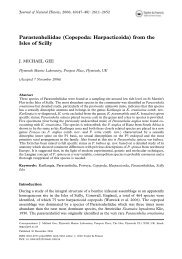An Updated Classification of the Recent Crustacea
An Updated Classification of the Recent Crustacea
An Updated Classification of the Recent Crustacea
You also want an ePaper? Increase the reach of your titles
YUMPU automatically turns print PDFs into web optimized ePapers that Google loves.
<strong>the</strong> former thaumastochelids being treated as Nephropidae),<br />
as <strong>the</strong>re was also strong support in<br />
<strong>the</strong>ir analysis for grouping at least some thaumastochelid<br />
genera toge<strong>the</strong>r (Tshudy and Babcock,<br />
1997: fig. 1).<br />
Superfamilies Astacoidea and Parastacoidea<br />
Monophyly <strong>of</strong> <strong>the</strong> freshwater crayfishes now appears<br />
secure based on adult morphology, sperm ultrastructure,<br />
embryology, and molecular data (e.g.,<br />
see Crandall, 1999; Crandall et al., 2000; Scholtz,<br />
1998, 1999). Scholtz (1998, 1999) reviews evolution<br />
<strong>of</strong> <strong>the</strong> crayfishes and confirms that <strong>the</strong>re are<br />
two distinct clades within <strong>the</strong> group (i.e., within his<br />
Astacida) corresponding to <strong>the</strong> nor<strong>the</strong>rn hemisphere<br />
Astacoidea (families Cambaridae and Astacidae,<br />
<strong>the</strong> latter <strong>of</strong> which is probably paraphyletic)<br />
and <strong>the</strong> sou<strong>the</strong>rn hemisphere Parastacoidea (family<br />
Parastacidae). Crandall et al. (2000), using over<br />
3000 nucleotides from 3 different genes, have confirmed<br />
both <strong>the</strong> monophyly <strong>of</strong> <strong>the</strong> freshwater crayfishes<br />
(Astacoidea Parastacoidea) as well as <strong>the</strong><br />
monophyly <strong>of</strong> <strong>the</strong> astacoid and parastacoid clades.<br />
Thus, our current classification is misleading in that<br />
<strong>the</strong>se two superfamilies (<strong>the</strong> Astacoidea and Parastacoidea)<br />
are still treated as being <strong>of</strong> equal rank<br />
with three o<strong>the</strong>r superfamilies in <strong>the</strong> Astacidea<br />
when in fact <strong>the</strong>y need to be depicted as more closely<br />
related to each o<strong>the</strong>r than ei<strong>the</strong>r is to any o<strong>the</strong>r<br />
astacidean superfamily. Scholtz (1999) also proposes<br />
that <strong>the</strong> crayfishes are not closely related to homarids<br />
(not supported by Crandall et al., 2000) but<br />
are instead members <strong>of</strong> ‘‘a large group including<br />
Thalassinida, <strong>An</strong>omala and Brachyura’’ (see also<br />
Scholtz and Richter, 1995). Taylor et al. (1999)<br />
added some insights into evolution within <strong>the</strong><br />
group based on well-preserved fossil material from<br />
China.<br />
INFRAORDER THALASSINIDEA<br />
Monophyly <strong>of</strong> <strong>the</strong> thalassinideans is uncertain; at<br />
least some morphological and molecular analyses<br />
indicate that <strong>the</strong> group is not monophyletic (e.g.,<br />
Tudge, 1995; Morrison and Cunningham, 1999).<br />
The propensity to construct complex vertical burrows<br />
is one character that has been postulated as<br />
defining <strong>the</strong> group (Atkinson and Taylor, 1988;<br />
Griffis and Suchanek, 1991; Scholtz and Richter,<br />
1995), as has <strong>the</strong> presence <strong>of</strong> a dense row <strong>of</strong> long<br />
setae along <strong>the</strong> lower margin <strong>of</strong> <strong>the</strong> second leg<br />
(Poore, 1994, 1997). We have followed <strong>the</strong> revision<br />
by Poore (1994:92) (who also established <strong>the</strong> family<br />
Strahlaxiidae), with <strong>the</strong> only difference being<br />
that some <strong>of</strong> <strong>the</strong> authors and dates <strong>of</strong> some taxa<br />
have been changed to earlier usages according to<br />
L. Holthuis (pers. comm.). Relationships among <strong>the</strong><br />
extant superfamilies, families, and genera were suggested<br />
by Poore (1994). Poore’s resulting classification<br />
(1997:92), like ours, does not adequately<br />
display all <strong>of</strong> <strong>the</strong> relationships suggested by his phylogenetic<br />
analysis (Poore, 1994:120). In particular,<br />
<strong>the</strong> Axioidea is <strong>the</strong> sister group to <strong>the</strong> Thalassinoidea<br />
Callianassoidea in his phylogeny, whereas<br />
in his classification, all three are treated as superfamilies.<br />
The family Ctenochelidae is acknowledged<br />
by Poore (1994) to be paraphyletic (although Tudge<br />
et al., 2000, argued for ctenochelid monophyly).<br />
Poore (1997) subsequently addressed three <strong>of</strong> <strong>the</strong>se<br />
families and <strong>the</strong>ir relationships in greater detail<br />
(Callianideidae Kossman, Micheleidae Sakai, and<br />
Thomassiniidae de Saint Laurent).<br />
In <strong>the</strong> superfamily Callianassoidea, <strong>the</strong> family<br />
Axianassidae was removed by Poore (1994), and<br />
<strong>the</strong> family Ctenochelidae was erected by Manning<br />
and Felder (1991). As noted above, Tudge et al.<br />
(2000) supported <strong>the</strong> monophyly <strong>of</strong> <strong>the</strong> family Callianassidae<br />
and <strong>the</strong> family Ctenochelidae (while<br />
noting that <strong>the</strong> latter includes, at least in <strong>the</strong>ir analysis,<br />
<strong>the</strong> genus <strong>An</strong>acalliax, considered by some<br />
workers to belong to <strong>the</strong> Callianassidae). In <strong>the</strong> superfamily<br />
Axioidea, Sakai (1992) first established<br />
<strong>the</strong> subfamily Micheleinae, elevated to family level<br />
(Micheleidae Sakai) by Poore (1994), and Poore<br />
(1994) erected <strong>the</strong> Strahlaxiidae. Sakai (1999) recently<br />
has proposed some ra<strong>the</strong>r large-scale revisions<br />
within <strong>the</strong> Callianassidae; his revisions are apparently<br />
at odds with o<strong>the</strong>r analyses <strong>of</strong> <strong>the</strong> same or<br />
similar taxa (e.g., see Tudge et al., 2000).<br />
INFRAORDER PALINURA<br />
Holthuis (1991) referred to this assemblage as <strong>the</strong><br />
Palinuridea, a spelling that would be consistent<br />
with some <strong>of</strong> our o<strong>the</strong>r infraorder names (such as<br />
Stenopodidea, Caridea) but not with o<strong>the</strong>rs (<strong>An</strong>omura,<br />
Brachyura). We have retained <strong>the</strong> spelling<br />
Palinura. Within <strong>the</strong> superfamily Palinuroidea, Davie<br />
(1990) felt that synaxids were not deserving <strong>of</strong><br />
separate familial status and synonymized <strong>the</strong> family<br />
Synaxidae with <strong>the</strong> Palinuridae. However, Holthuis<br />
(1991) continued to recognize <strong>the</strong>m as separate<br />
families, and we have maintained <strong>the</strong>m as separate<br />
families here as well. The family Polychelidae has<br />
been recently reviewed and rediagnosed by Galil<br />
(2000). Removal <strong>of</strong> <strong>the</strong> glypheoids from this infraorder<br />
to <strong>the</strong> Astacidea has been noted above.<br />
INFRAORDER ANOMURA<br />
Our classification follows McLaughlin’s (1983b)<br />
fairly closely, with <strong>the</strong> exception <strong>of</strong> <strong>the</strong> use <strong>of</strong> <strong>the</strong><br />
family name Pylochelidae replacing Pomatochelidae<br />
(following Forest, 1987). McLaughlin (1983a,<br />
b) employed <strong>the</strong> name <strong>An</strong>omala De Haan (as had<br />
Burkenroad, 1981) ra<strong>the</strong>r than <strong>An</strong>omura H. Milne<br />
Edwards, which had been used by Bowman and<br />
Abele (and many o<strong>the</strong>r workers). G. Scholtz (pers.<br />
comm.) also would prefer this usage (<strong>An</strong>omala over<br />
<strong>An</strong>omura), arguing that when <strong>the</strong> thalassinoid families<br />
are removed <strong>the</strong> taxon composition changes<br />
and thus <strong>the</strong> name <strong>An</strong>omala is <strong>the</strong> more accurate.<br />
Use <strong>of</strong> <strong>An</strong>omala over <strong>An</strong>omura was reconsidered<br />
and discussed at length by McLaughlin and Holthuis<br />
(1985), who pointed out that both names<br />
Contributions in Science, Number 39 Rationale 47











